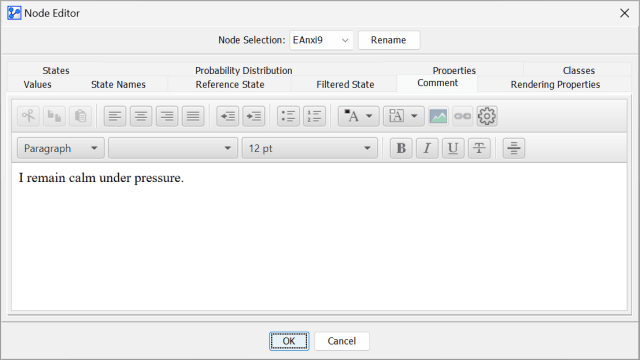Class Description Generator
Context
- To manage groups of nodes, BayesiaLab offers Classes.
- Nodes can be added to Classes manually or automatically. For instance, the Variable Clustering function can assign nodes to new Classes representing latent factors. By default, newly-created Classes have generic names, such as [Factor_0], which carries no meaning.
- Finding suitable descriptions for Classes can be time-consuming.
- The Class Description function can assist you in finding meaningful summaries of a Class of nodes.
Using Class Description Generator for Groups of Nodes
- With the Hellixia Class Description Generator, we can quickly find a useful description for a subset of nodes we select.
- In our example, we have a large number of nodes from an auto buyer satisfaction survey.
- We are interested in a subset of nodes related to the quality perception of the vehicle interior, i.e.:
- Interior Colors
- Quality of Interior Materials
- Interior Trim & Finish
- Quality of Seat Materials
- Select these nodes node of interest.
- Then select
Menu > Hellixia > Class Description. - Specify a Context, if applicable.
- Indicate by ticking the checkboxes where the subject matter is stored, i.e., Node Name, Node Long Name, or Node Comment. Check all that apply.
- Clicking OK starts generating the Class Description.
- The chime confirms when the process is complete.
- Opening the Class Editor shows the Class Description that was generated.
- Select
Graph Contextual Menu > Edit Classes - The Description column shows the newly-generated Class Description.
Workflow Illustration
Using the Class Description Generator from within the Class Editor
- BayesiaLab’s Clustering function produces new Factors and associated Classes.
- So, having a dozen or more new Classes is quite common in this context.
- By default, the newly-generated Classes have generic and non-informative names, like [Factor_0], [Factor_1], etc.
- Given that the Factors and Classes are meant to represent meaningful concepts, naming them is important but can be tedious.
- In the following example, 57 Factors (and Classes) were created from 240 manifest nodes. Each manifest node measures the degree of agreement or disagreement with statements in a personality test, such as, “I get angry easily” or “I remain calm under pressure.”
- These original statements are included as Node Comments with every node.

